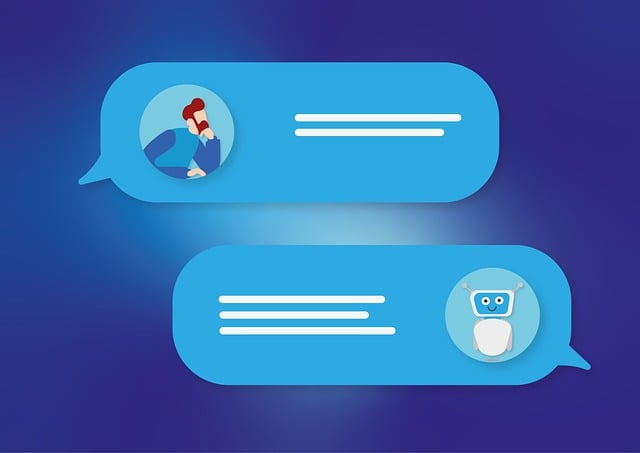AI chatbots have revolutionized online interactions by providing human-like conversational experiences, leveraging advanced NLP and machine learning. These chatbots utilize extensive datasets to learn from various linguistic contexts, refining their conversational abilities continuously. In sectors like e-commerce, they assist with product selection, shipping details, and personalized recommendations. Customer service chatbots handle routine queries efficiently, allowing human agents to address more complex issues. Beyond commerce, AI chatbots offer preliminary medical guidance, mental health support, and appointment scheduling in healthcare. The integration of these chatbots into web platforms not only optimizes operations but also significantly enhances user satisfaction by providing immediate, coherent, and context-sensitive assistance. Building effective AI chatbots for web deployment involves a robust NLP framework, open-source libraries like TensorFlow or Hugging Face's Transformers, diverse training datasets to handle multiple topics and queries, and a user-friendly interface with conversational flows and real-time APIs. For online deployment, Transformer models like GPT are often preferred due to their scalability, adaptability, and superior performance in understanding and generating human-like text. The effectiveness of these chatbots is contingent on careful selection and preparation of datasets, which must be diverse and extensive to ensure the AI can engage in coherent and contextually relevant conversations across different languages, dialects, and cultural contexts. Fine-tuning with real-world interactions enhances their conversational skills, making AI chatbots an indispensable tool for seamless online communication and engagement.
Delving into the realm of artificial intelligence, this article provides a comprehensive guide on crafting an AI chatbot that can generate responses in real-time. Known as generative AI chatbots, these advanced tools are revolutionizing online interactions across various sectors. From customer service to personal assistants, their applications are vast and growing. This exploration covers the fundamental components required to build such a chatbot, including data collection, model selection, and training. We’ll then navigate through setting up your development environment, integrating NLP libraries, and fine-tuning your bot for specific tasks. Subsequently, we discuss designing an intuitive user interface, choosing appropriate frameworks, and ensuring your chatbot can handle large-scale interactions efficiently. Finally, we address deployment strategies, highlighting best practices to ensure your AI chatbot thrives online, from hosting solutions to security and compliance with data privacy regulations. Whether you’re a developer or a business looking to leverage AI chatbots online, this article will equip you with the knowledge to create an engaging, responsive, and scalable chatbot.
- Understanding Generative AI Chatbots and Their Online Applications
- Key Components of Building a Generative AI Chatbot for the Web
- – Data Collection and Preprocessing
- – Model Selection: Transformer Models and Beyond
- – Training Your Model with Large-Scale Datasets
Understanding Generative AI Chatbots and Their Online Applications

Generative AI chatbots represent a significant advancement in artificial intelligence, particularly within the realm of online interactions. These sophisticated systems harness natural language processing and machine learning to simulate human-like conversation, enabling them to understand, interpret, and generate responses to user queries effectively. The underlying technology of these chatbots is built upon vast datasets, allowing them to learn from a wide array of linguistic patterns and contexts, thereby improving their conversational abilities over time.
The applications of AI chatbots online are diverse and far-reaching, transforming how businesses engage with customers, provide support, and offer personalized experiences. E-commerce platforms leverage these chatbots to assist users in navigating product selections, answering questions about shipping and returns, and offering recommendations based on user behavior. Similarly, customer service departments use AI chatbots to handle routine inquiries, thereby freeing up human agents to tackle more complex issues. Healthcare services also employ generative AI chatbots to deliver preliminary medical information, mental health support, and to assist patients with scheduling appointments and understanding treatment options. The integration of AI chatbots into various online platforms not only streamlines operations but also enhances user satisfaction by providing instant, consistent, and contextually relevant assistance.
Key Components of Building a Generative AI Chatbot for the Web

To construct an effective generative AI chatbot for web deployment, several key components must be meticulously integrated to ensure a seamless and intelligent conversational interface. Central to this endeavor is the selection of an appropriate Natural Language Processing (NLP) framework. This framework enables the chatbot to understand and generate human-like text by processing user input and formulating coherent responses. Open-source libraries like TensorFlow, PyTorch, or Hugging Face’s Transformers provide robust NLP capabilities that can be fine-tuned for conversational contexts.
In addition to the NLP foundation, a generative AI chatbot requires a machine learning model trained on diverse datasets to handle a wide range of topics and user queries. Pre-trained models such as GPT (Generative Pre-trained Transformer) or BERT (Bidirectional Encoder Representations from Transformers) serve as powerful starting points due to their deep understanding of language contexts. These models can be further customized with additional layers or fine-tuned on domain-specific data to enhance their performance and relevance for online users. Furthermore, integrating a user interaction interface that is intuitive and accessible is crucial for engaging users in natural conversations. This involves designing a conversational flow and implementing a robust API that can handle asynchronous interactions in real-time, ensuring the chatbot is responsive and provides a satisfying user experience on the web.
By carefully constructing these components, developers can create a generative AI chatbot capable of delivering human-like interactions online, thus providing users with immediate assistance, entertainment, or information as needed.
– Data Collection and Preprocessing

When embarking on the creation of a generative AI chatbot, the foundation is laid through meticulous data collection and preprocessing. Initially, sourcing high-quality conversational datasets is paramount for training models that can understand and generate human-like responses. These datasets must be diverse and extensive to ensure the chatbot can handle a wide array of topics and user intents. The data should encompass various domains, reflecting the multifaceted nature of human dialogue. It’s crucial to gather text from legitimate sources to avoid any biases or inaccuracies that could skew the chatbot’s performance.
Once the data is collected, preprocessing becomes a critical step. This phase involves cleaning and structuring the data to be suitable for model training. Cleaning involves removing noise such as irrelevant symbols, correcting typos, and standardizing language variations. Structuring entails organizing the data in a format that the AI can interpret, often involving tokenization, where text is broken down into tokens like words or phrases. This step also includes anonymizing sensitive information to protect user privacy. The effectiveness of the generative AI chatbot heavily relies on the quality of these initial stages, ensuring that the final model is robust and capable of engaging in coherent online interactions with users. Utilizing advanced natural language processing techniques during preprocessing can significantly enhance the performance of ai chatbots online by improving their ability to understand context and generate relevant responses.
– Model Selection: Transformer Models and Beyond

When constructing a generative AI chatbot, the model selection phase is pivotal, as it determines the performance and capabilities of your bot. Among the most advanced architectures for natural language processing are Transformer models, which have significantly outperformed traditional machine learning approaches. These models, including OpenAI’s GPT (Generative Pre-trained Transformer) series, have set new standards for understanding and generating human-like text. They are particularly adept at tasks like conversation, where the context and coherence over longer spans of dialogue are crucial. For those seeking AI chatbots online that can engage users in a natural and compelling manner, Transformer models are often the first choice due to their scalability and versatility.
Beyond the Transformer paradigm, there are emerging models that offer enhanced capabilities or more efficient deployment options. For instance, Google’s T5 (Text-to-Text Transfer Transformer) model, which treats every NLP task as a text-to-text problem, has shown promise in its ability to be fine-tuned for a wide array of applications. Additionally, models like BERT (Bidirectional Encoder Representations from Transformers) and RoBERTa (A Robustly Optimized BERT Pretraining Model) continue to be influential, especially when computational resources are at a premium. When selecting a model for your chatbot, consider factors such as the intended use case, the linguistic diversity required, and the computational constraints of the environment where the chatbot will operate. By carefully evaluating these aspects, you can choose the most suitable AI chatbot model to ensure your chatbot delivers optimal performance online.
– Training Your Model with Large-Scale Datasets

In constructing a generative AI chatbot, the cornerstone of its performance lies in the training process with extensive datasets. Leveraging large-scale datasets is paramount for teaching your model the nuances of human language, enabling it to converse effectively online. These datasets should ideally encompass a wide array of dialogues, questions, and responses, spanning various domains to ensure the chatbot can handle diverse interactions. The quality and quantity of the data determine how well your AI understands context, maintains coherence over multiple exchanges, and generates relevant and informative replies. By employing machine learning algorithms that can process this wealth of information, your model will learn the patterns of language use and adapt to the vastness of human conversation, thereby delivering a seamless and intuitive online experience for users interacting with AI chatbots.
When selecting datasets for training, it’s crucial to ensure they are representative of different languages, dialects, and cultural contexts if you wish to deploy your chatbot globally. This inclusivity not only enhances the chatbot’s ability to communicate with a broader audience but also reduces the risk of biases that can arise from unbalanced or narrow training data. Additionally, incorporating datasets from various online platforms where human interactions are natural and authentic further refines the chatbot’s conversational abilities. By fine-tuning your model with such diverse and comprehensive data, you can create a robust AI chatbot capable of delivering high-quality interactions, making it an invaluable tool for businesses and users alike in the realm of online communication.
In conclusion, building a generative AI chatbot for the web involves a multifaceted approach that encompasses data collection and preprocessing, model selection from cutting-edge transformer models, and extensive training with large-scale datasets. By understanding the intricacies of generative AI chatbots and their myriad applications online, developers can create sophisticated conversational agents capable of enhancing user experience across various platforms. The key to success lies in the careful curation of data and the judicious choice of model architecture, ensuring that your chatbot not only functions effectively but also adheres to ethical guidelines and provides value in its interactions. As AI chatbots online continue to evolve, staying abreast of the latest advancements and best practices will be paramount for developers aiming to push the boundaries of what these systems can achieve.
